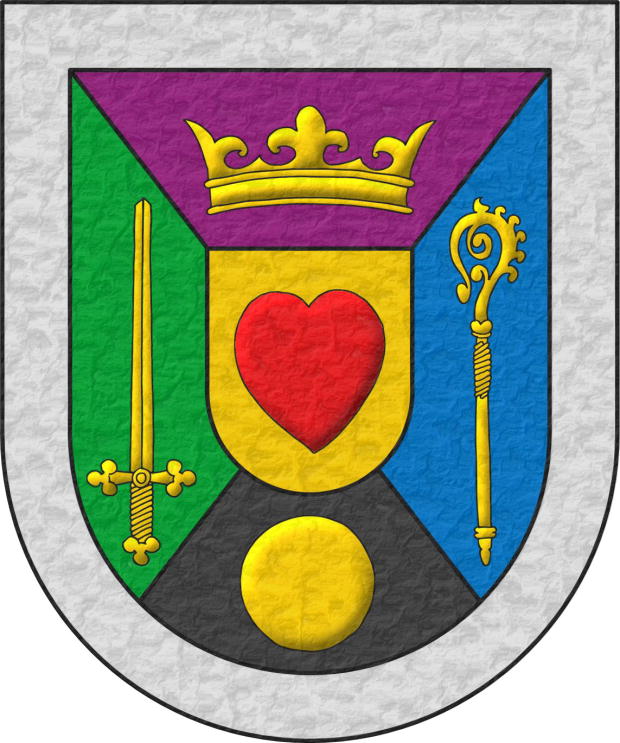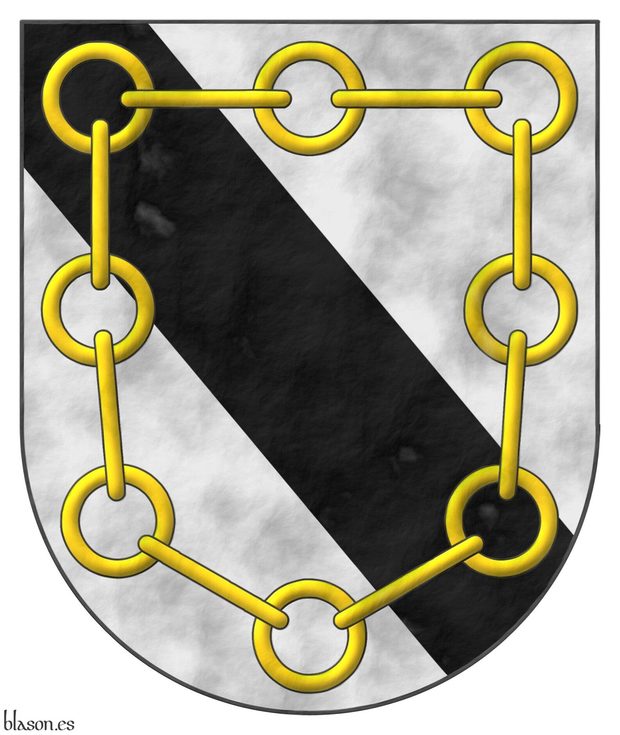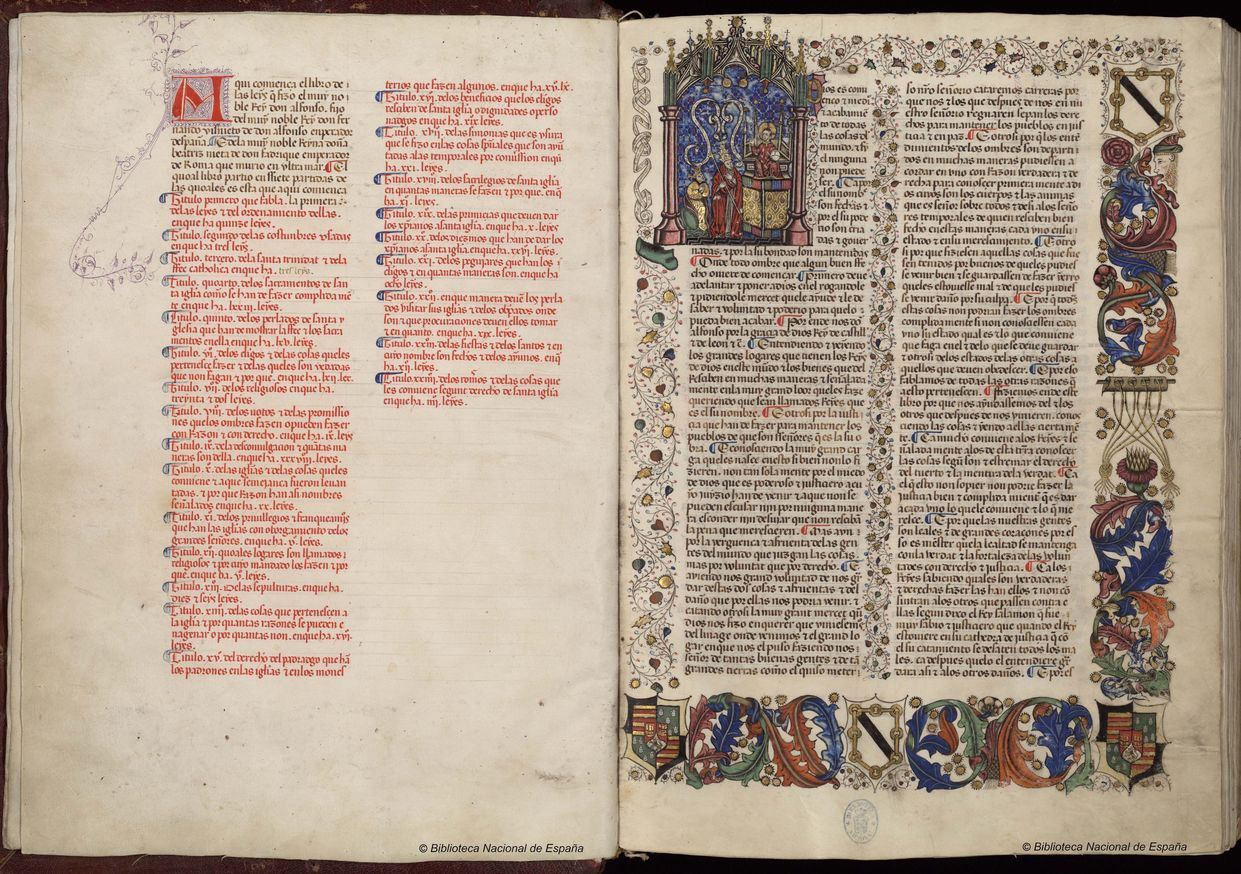
![Ver [Heraldic classification] en criterios utilizados. Unicornio saltante sobre la divisa, criterio.](../css/Unicornio.Criterio.png)
Heraldic classification
I classify the coats of arms that I interpret or create depending on the field of the bearer of these armories and I do so within one of the following six categories:
- Personal heraldry.
- Governance heraldry.
- Military heraldry.
- Religious heraldry.
- Socioeconomic heraldry.
- Imaginary heraldry.
With their similarities and differences, there are many classifications within heraldry, some of which come from recognized authors. This specific classification, presented here, does not aim to be more than my personal way of classifying and organizing the coats of arms that I interpret or create.
As with any classification structure within a varied and rich universe of occurrences, as is the case with heraldry, there are always specific instances that belong or may belong to 2 or more classes, in these cases, I include the coat of arms in the one that seems most reasonable and provides the quickest and most logical location.
It could be suggested that this classification corresponds to the human being, in personal heraldry, and to their four most characteristic ways of organizing from a heraldic perspective: a) political and governance structures, b) military, c) spiritual and religious, and d) those of an economic or social nature. Allowing, in a sixth and final section of imaginary heraldry, for those creations of impossible ownership, on the border of heraldry and which, despite this, we do not want to exclude. The appeal of imaginary heraldry is that it is like a blank canvas on which we can create a coat of arms for someone or something with more freedom than in the other classes.

Imaginary coat of arms that encompasses the 6 classes of heraldry.
The quartered in saltire shield that illustrates this article symbolizes these 6 classes of heraldry:
- In the escutcheon of Or, a heart Gules symbolizes personal heraldry, the nobility of people, the love of family, and the blood of lineage.
- The 1st of Purpure and the crown Or represent political and governance structures and their heraldry, with Purpure being a color associated with power since Roman times.
- The 2nd of Vert and the sword point upwards Or, in open field, a vert battlefield, symbolizes military heraldry.
- The 3rd of Azure, the color of the sky, and the crozier Or is the representation of religious heraldry.
- The 4th of Sable, reminiscent of an industrial or mining ground, and a bezant, always Or, representing currency and money, symbolizes socioeconomic heraldry.
- The bordure Argent, as an outer border, frontier, or blank canvas, is the proper domain of imaginary heraldry.
Reflections on governance heraldry
In my approach to heraldry, I choose to unify political and civic heraldry under the broader concept of «governance heraldry». While modern terminology often distinguishes «civic heraldry» as a separate entity, with professionals focusing specifically on municipal arms, I see a deeper connection. Historically, the heraldry of kingdoms and kings was frequently intertwined; the arms of regions or realms were quartered to create the arms of united kingdoms. These kingdoms were often divided into regions and provinces, with cities frequently founded by royal orders and granted certain privileges.
Thus, I bring all of these elements together under the concept of «governance heraldry», in Castilian «heráldica política». Although in English this is often translated as «civic heraldry» to align with contemporary usage, a more precise term might be «political and civic heraldry». However, this combination does not fully convey the interconnectedness of all forms of heraldic expression related to governance, whether at the level of a kingdom, region, or municipality.
Category: Criterion.


![Ver [Personal Heraldry] en criterios utilizados. Unicornio saltante sobre la divisa, criterio.](../css/Unicornio.Criterio.png)
Personal Heraldry
Within personal heraldry, I classify the arms of individuals, their families, or lineages.
When a coat of arms representing a person, such as in the case of a king, is also used to represent something else, such as their kingdom, I classify it as personal heraldry, prioritizing the representation of the individual over other possible uses, as this is the origin of heraldry.
The historical arms of Carlos de la Cerda or the current ones of Austin Charles Berry and of Stephan Urs Breu are examples of personal heraldry.
In Spanish, I use the name given by [Cadenas y Vicent, V. de; 1975; page 53] and in English «personal heraldry», which is the most commonly accepted term.
Categories: Criterion and Personal.


![Ver [Governance heraldry] en criterios utilizados. Unicornio saltante sobre la divisa, criterio.](../css/Unicornio.Criterio.png)
Governance heraldry
Within governance heraldry, I classify the arms of states, as political structures, and those of their powers, their governing and administrative institutions, and their organizational substructures, such as regions, provinces, municipalities, etc.
The arms of Bosnia and Herzegovina, of Bunyoro-Kitara, and of Ceuta are examples of political heraldry.
This class partially coincides with what [Cadenas y Vicent, V. de; 1975; page 87] refers to as «institutional heraldry».
Categories: Criterion and Civic.


![Ver [Military heraldry] en criterios utilizados. Unicornio saltante sobre la divisa, criterio.](../css/Unicornio.Criterio.png)
Military heraldry
Within military heraldry, I classify the arms of individuals, institutions, orders, military corps, and entities.
Although the military is an institution of the state, I dedicate a separate category to it in recognition of its special characteristics and history, as well as its particular functions of cohesion and identification, which are rooted in heraldry for the battlefield. The coat of arms of the Central Military Region and the Artillery Combat School of the Swedish Army are examples of military heraldry.
[Cadenas y Vicent, V. de; 1975; page 88] includes military heraldry within his «institutional heraldry».
Categories: Criterion and Military.


![Ver [Religious heraldry] en criterios utilizados. Unicornio saltante sobre la divisa, criterio.](../css/Unicornio.Criterio.png)
Religious heraldry
Within religious heraldry, I classify the arms of individuals, offices, dignitaries, institutions, communities, orders, and religious entities, primarily, by tradition, those of the Church.
The arms of the Order of Mercy and those of the Oratorio de San Felipe Neri are examples of religious heraldry.
Being more general, this category encompasses what [Cadenas y Vicent, V. de; 1975; page 59] refers to as «ecclesiastical heraldry».
Categories: Criterion and Religious.


![Ver [Socioeconomic heraldry] en criterios utilizados. Unicornio saltante sobre la divisa, criterio.](../css/Unicornio.Criterio.png)
Socioeconomic heraldry
Within socioeconomic heraldry, I classify the arms of all collectives not included in the previous categories, such as, for example, commercial societies, which may represent companies, their brands, and products, sports clubs and federations, associations, professional colleges, educational institutions, arms granted or assumed collectively, etc.
For example, the coats of arms of universities, both private and public, belong to this category, the former naturally and the latter considering their appropriate autonomy from state powers. In this way, the coat of arms of the IESE, as a business school, is an example of socioeconomic heraldry.
Also included are the coats of arms of associations, like the Norsk Heraldisk Forening, and of companies, such as the arms of Alea Capital.
This category partially coincides with what [Cadenas y Vicent, V. de; 1975; page 119] refers to as «representative heraldry».
Categories: Criterion and Socioeconomic.


![Ver [Imaginary heraldry] en criterios utilizados. Unicornio saltante sobre la divisa, criterio.](../css/Unicornio.Criterio.png)
Imaginary heraldry
Within imaginary heraldry, I classify the arms attributed to persons, entities, or things, real, mythical, or imaginary, that could not or cannot possess them, or if they did, their existence is unknown, or due to various circumstances, they neither could nor can assume them.
For example, the coat of arms of Odysseus of Ithaca, legendary hero of Greek mythology, of Brutus of Britain, mythical hero of Troy and founder of Britain who never existed, of Seneca, who historically existed, but could not have had arms as he lived before heraldry, of Hufflepuff at Hogwarts from the Harry Potter books, of the Holy Trinity, of logic, of arithmetic, or of the categories of heraldry.
Categories: Criterion and Imaginary.


![Ver [Alfonso X of Castile; 1265] en referencias bibliográficas. Libro abierto, hojas de plata, filo de oro, guardas de gules, tapas de sable.](../css/Libro.Bibliografia.png)
Alfonso X of Castile; 1265

Alfonso X of Castile, The Wise, «The Seven-Part Code», its estimated completion year is 1265.
This is the copy I can consult, as it is available in the Hispanic Digital Library, it is a manuscript measuring 42 by 30 centimeters that once belonged to Álvaro de Zúñiga y Guzmán, first Duke of Arévalo, which later came into the possession of the Catholic Monarchs, initially Queen Isabella I of Castile, and after her death, King Ferdinand reclaimed it for the price of 5,251 maravedis. The original is housed in the National Library, in display case 4/6.
This copy, in addition to its numerous capital letters, has 8 illustrated pages, which according to its subsequent hand-numbering in pencil are:
- Page 6, among its illustrations can be seen 2 coats of arms of the Zúñiga family «Argent, a bend Sable, over all, a chain in orle Or», in this case formed by 16 links, 8 round and 8 more elongated placed in profile.
- Pages 106 and 191, on the latter can be seen a curious bishop-lizard climbing.
- Pages 294 and 331, on the 2nd at the bottom, a maiden is seen walking a monkey to relieve itself and to her right a fight of men with beast bodies.
- Page 379 and on its previous unnumbered page, and finally, on page 415 which begins with a tournament where the 2nd knight bears the ancient arms of France «Azure, semy of fleurs de lis Or».
The coat of arms that illustrates this bibliographic reference is that of Álvaro de Zúñiga y Guzmán. For the creation of his chain, I followed the illustration of his 2 coats of arms on the already mentioned page 6 of this manuscript.
It is one of my favorite manuscripts and, perhaps, the one with which I have created the most things.
Bibliographical reference of century XIII.
Classification: Castilian language, Manuscript and In color.
Author: Alfonso X of Castile.
Bibliographical reference mentioned in the following article:
External resources:
- National Library of Spain.
- Indirect access to the Library of Congress of the United States of America.
- Direct access to the Library of Congress of the United States of America.
Internal resources: AlfonsoXDeCastilla1265.7Partidas.10642.pdf.

Continue with: Guimera López, C.; 1987.
-
Language
-
Categories of heraldry
-
Divisions of the field
- Without divisions
- Party per pale
- Party per fess
- Party per bend
- Party per bend sinister
- Tierce
- Tierce sinister
- Tierced per pale
- Tierced per fess
- Tierced per bend
- Tierced pallwise inverted
- Quarterly
- Quarterly per saltire
- Gyronny
- Party per fess, the chief per pale
- Party per pale, the sinister per fess
- Party per fess, the base per pale
- Party per pale, the dexter per fess
- Chapé
- Chaussé
- Embrassé
- Contre-embrassé
- Party per chevron
- Enté
- Enté en point
- Flanched
-
Metals
-
Colours
-
Furs
-
Other tinctures
-
Ordinaries and sub-ordinaries
-
Diminutives of the ordinaries
-
Other charges
-
Inanimate charges from Nature
Atom, Crescent, Diamond, Emerald, Estoile, Increscent, Lightning flash, Moon, Mount, Mullet, Mullet of four points, Orbital, Plough of Ursa Major, Rainbow, Ray of the sun, River, Sea, Snowflake, Sun, Sun in splendour, Sun of May, Trimount and Water.
-
Vegetal charges from Nature
Acorn, Apple, Apple tree, Ash, Bluebonnet, Camellia, Chrysanthemum, Cinquefoil, Cornflower, Dogwood flower, Double rose, Elm, Fleur de lis, Flower, Holm oak, Hop cone, Kapok tree, Laurel, Lily, Linden, Lotus flower, Madonna lily, Oak, Olive tree, Palm tree, Pomegranate, Poplar leaf, Rose, Shamrock, Sunflower, Thistle, Tree, Tulip, Vine and Wheat.
-
Animal charges from Nature
Badger, Bald eagle, Barbel, Barn owl, Bear, Beaver, Beetle, Bighorn sheep, Blackbird, Boar, Brach hound, Bull, Doe, Dog, Dolphin, Dove, Eagle, Elephant, Falcon, Fish, Flame, Fly, Fox, Frog, Goat, Goldfinch, Goose, Heron, Horse, Hummingbird, Jaguar, Lark, Leopard, Lion, Lion passant, Lion rampant guardant, Lioness, Lynx, Male figure, Martlet, Merino ram, Owl, Panther, Parrot, Peacock, Pelican, Pelican in her piety, Puffin, Quetzal, Raven, Roe deer, Rooster, Savage, Seagull, Serpent, She-wolf, Stag, Starling, Tyger, Vulture, Warren hound and Wolf.
-
Parts of natural charges
Arm, Beak, Branch, Caboshed, Chest, Claw, Covert, Dorsal fin, Eagle claw, Ermine spot, Escallop, Feather, Foot (palmiped), Foreleg, Forepaw, Hand, Head, Heart, Hoof, Leaf, Neck, Ostrich feather, Palm frond, Paw, Roe deers' attires, Shoulder, Sprig, Stags' attires, Stem, Swallow-tail, Tail, Tail addorsed, Tail fin, Talon, Tooth, Trunk, Trunk (elephant), Two hands clasped, Two wings in vol, Udder, Wheat spike, Wing and Wrist.
-
Artificial charges
Ace of spades, Anchor, Anvil, Arch, Arm vambraced, Armillary sphere, Arrow, Axe, Bell, Bell tower, Beret, Bonfire, Book, Bookmark, Bow, Bridge, Broken, Buckle, Cannon, Cannon dismounted, Cannon port, Carbuncle, Castle, Celtic Trinity knot, Chain, Chess rooks, Church, Clarion, Clay pot, Closed book, Club, Comb, Compass rose, Conductor's baton, Cord, Covered cup, Crozier, Crucible, Cuffed, Cup, Cyclamor, Dagger, Double vajra, Drum, Ecclesiastical cap, Fanon, Federschwert, Fleam, Four crescents joined millsailwise, Galician granary, Garb, Gauntlet, Geometric solid, Grenade, Halberd, Hammer, Harp, Host, Hourglass, Key, Key ward, Knight, Knot, Lantern, Letter, Line, Loincloth, Menorah, Millrind, Millstone, Millwheel, Monstrance, Mortar, Mullet of six points pierced, Nail, Non-classic artifact, Norman ship, Number, Oar, Oil lamp, Open book, Page, Pair of scales, Parchment, Pestle, Piano, Plough share, Polish winged hussar, Port, Portcullis, Potent, Quill, Ribbon, Rosette of acanthus leaves, Sabre, Sackbut, Sail, Scroll, Scythe, Sheaf of tobacco, Ship, Skirt, Spear, Spear's head, Stairway, Star of David, Step, Sword, Symbol, Tetrahedron, Torch, Tower, Trident, Trumpet, Turret, Two-handed sword, Wagon-wheel, Water-bouget, Wheel, Winnowing fan and With a turret.
-
Immaterial charges
Angel, Archangel, Basilisk, Dragon, Dragon's head, Garuda, Golden fleece, Griffin, Heart enflamed, Mermaid, Our Lady of Mercy, Ouroboros, Paschal lamb, Pegasus, Phoenix, Sacred Heart of Jesus, Saint George, Sea-griffin, Trinity, Triton, Unicorn, Winged hand and Wyvern.
-
External elements
-
Heraldic creations
-
References
-
Formats
-
Keywords on this page
Bend, Bibliography, Surmounted, Chain, Criterion, In color, Personal, Imaginary, Castilian language, Manuscript, Military, Orle, Or, Argent, Without divisions, Civic, Kingdom of Castile and Leon, Religious, Sable, Century XIII, Century XX and Socioeconomic.
